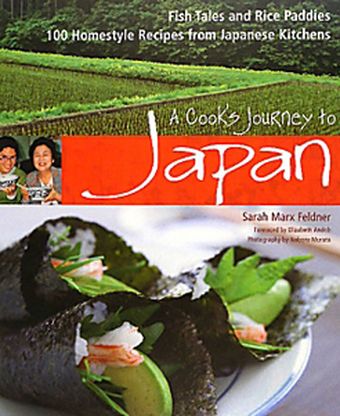Judging this tournament makes me feel like a kid doing a book report. I wasn’t so great at those, but I will try my best on this "assignment." When I look at a cookbook, I want it to meet certain criteria. Is it inviting? Does it transport me someplace? Will I learn something from it? Will the recipes be functional for the rest of the world? Sounds pretty straightforward, right? I buy hundreds of cookbooks of all kinds and, sure, they don’t always meet those criteria. I often buy books in languages I cannot read just for the step-by-step photos. What can I say? I’m a sucker for great photos.
Trying to review or choose one of these cookbooks to move forward was not an easy task. Each had its own special characteristics that made me love it. What I found most amusing about this experience is that:
1. It reminded me I'm a sucker for Asian food.
2. Though they both deal with Asian cuisine (one Japanese; the other Thai), the two books are complete opposites. The dishes in the book on Thai street food are very elaborate and require a lot of ingredients, while the cookbook about Japanese home-cooking is simpler and calls for a maximum of only five ingredients per recipe.
To face the task at hand, I chose four recipes from each book and cooked all the dishes in my home kitchen with regular household appliances and kitchenware. No fancy restaurant shit. In both cases, I tested the food on my family and some friends. I chose recipes that were a balanced mix for the group, which included my five-year-old son.
I approached Sarah Marx Feldner’s A Cook's Journey to Japan first. The book’s opening section is dedicated to educating the reader about equipment, ingredients and the basic techniques needed to produce the published recipes. Not surprisingly, I enjoyed the step-by-step photos provided for novices and found the cooking tips and bits of knowledge informative and helpful. But, while the food transported us to Japan, the visuals didn’t. The few inside-cover shots -- a collage of portraits, food market stills, and scenic pictures -- left me feeling cheated, and my foggy backyard in San Francisco wasn’t compensating. I wish there were more photos of the people and the culture that surrounded the author’s experiences in that country.
The menu: miso soup with baby clams, yakitori chicken skewers, soy-glazed chicken wings, and soy sauce udon noodles.
Making these dishes was fun -- they were soulful and totally suited to everyday cooking. I followed every recipe to a T; each worked very well, was precisely written and easy to prepare. Ultimately, the thing I liked about the book is that it worked. It's refreshing. It was to the point and exact. The one issue I had was with the recipe for chicken wings. It instructs you to put the wings under the broiler for ten minutes, and I felt that burned the wings too much (my guests thought they were great, though). To be fair, each broiler heats differently; maybe that should have been taken into consideration during recipe testing.
Then three days later, I tackled David Thompson’s Thai Street Food. This book is massive in every way possible. Large size. Large recipes. Large photos. It’s visually stunning. The images gave me a glimpse into the author’s inspiration and made me want to go to Thailand and eat street food. Like right now.
The menu: green papaya salad (yes, I made it with a mortar and pestle like the recipe said), sour pork sausages from Udon (the capital of Udon Thani Province in Thailand), stir-fried squid with flowering garlic chives, and finally rice congee with minced pork and egg.
The prep process took a few days. I had to source all of the ingredients, and there were a lot; it was a hunt and gather process that required I hit up a few different markets (which could be tough for some folks). Then there was the cooking itself. It amazed me that these were street food dishes since there were so many steps and ingredients.
The green papaya salad was very tasty; the mortar and pestle procedure was enjoyable and produced a great final dish. While I was preparing the squid, it instantly occurred to me that there is no way I or any home cook could get a pan hot enough to simulate the proper stir-fry heat used to cook the squid. This proved to be true. As my pan was about to burst into flames, I threw in the squid; two seconds later, there was not even a simmer. So the squid barely bubbled and limped along -- probably not what the street food version would have done. Everyone loved the dish, but I knew it could taste better. I could smell that heat and the flavor it would have produced in my mind, but couldn’t achieve it. No home cook has enough fire power or gas BTUs to get the heat to the pan properly, unless you took the one recipe and did it in three batches. But who would want to do that? You'd have to wash out the pan after each batch or else the leftover sauce would scald. If you have a professional range and a black steel wok, you'll be fine.
The sausages were a no-brainer for me; since we opened Boccalone three years ago, producing sausage and salami is part of my life. I loved their flavor but found them to be a bit salty. There was no amount specified for the salt listed among the ingredients, which is especially problematic because the overnight fermenting concentrates the flavors; it’s hard to know just how much seasoning to add to the base. The congee recipe had a similar flaw -- the specific amount of liquid (water, stock or whatever your base) required wasn’t indicated in the list of ingredients. I found it later in the directions, but most people who use cookbooks look at that list before they start the process, and that missing bit of information could lead to a crisis later. Still, the finished product was great. The topping choices were perfect -- there's the egg, the scallions, ginger and Chinese deep-fried bread. It's a classic combination; it's all about building and balancing flavors -- you have the fat, the richness from the egg, the saltiness of the pork, and the freshness of the onions and the ginger. I have made it again since; the recipe tells you to use salty pork, so I used prosciutto. It worked.
Although everyone was enthusiastic about the meal, there’s something to be said for the fact that I have been cooking professionally for over 15 years and it took me all day to prepare four of Thompson’s dishes. And so, I have come to the conclusion that maybe, except for that congee, I should leave Thai street food to the experts.
All in, I must say this was a fun experience and a very hard decision. If I had to pick one book to advance, it would be A Cook's Journey to Japan. We’re still preparing recipes from this book.
See a photo slideshow of Chris's cooking adventures here.



5 Comments